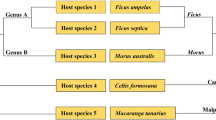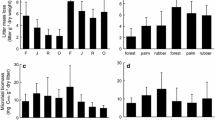Abstract
This study was designed to examine saprophytic fungi diversity under different tree species situated in the same ecological context. Further, the link between the diversity and decomposition rate of two broadleaved, two coniferous and two mixed broadleaved-coniferous litter types was targeted. Litter material was decomposed in litter bags for 4 and 24 months to target both early and late stages of the decomposition. Fungal diversity of L and F layers were also investigated as a parallel to the litter bag method. Temperature gradient gel electrophoresis fingerprinting was used to assess fungal diversity in the samples. Mass loss values and organic and nutrient composition of the litter were also measured. The results showed that the species richness was not strongly affected by the change of the tree species. Nevertheless, the community compositions differed within tree species and decomposition stages. The most important shift was found in the mixed litters from the litter bag treatment for both variables. Both mixed litters displayed the highest species richness (13.3 species both) and the most different community composition as compared to pure litters (6.3–10.7 species) after 24 months. The mass loss after 24 months was similar or greater in the mixed litter (70.5% beech–spruce, 76.2% oak–Douglas-fir litter) than in both original pure litter types. This was probably due to higher niche variability and to the synergistic effect of nutrient transfer between litter types. Concerning pure litter, mass loss values were the highest in oak and beech litter (72.8% and 69.8%) compared to spruce and D. fir (59.4% and 66.5%, respectively). That was probably caused by a more favourable microclimate and litter composition in broadleaved than in coniferous plantations. These variables also seemed to be more important to pure litter decomposition rates than were fungal species richness or community structure.





Similar content being viewed by others
References
Adl S (2003) The ecology of soil decomposition. CABI, Wallingford
Aerts R (1997) Climate, leaf litter chemistry and leaf litter decomposition in terrestrial ecosystems: a triangular relationship. Oikos 79:439–449
Anderson IC, Cairney JWG (2004) Diversity and ecology of soil fungal communities: increased understanding through the application of molecular techniques. Env Microbiol 6:769–779
Berg B (2000) Litter decomposition and organic matter turnover in northern forest soils. For Ecol Manag 133:13–22
Berg B, Kniese JP, Verhoef HA (1998) Dynamics and stratification of bacteria and fungi in the organic layers of Scots pine forest soil. Biol Fertil Soils 26:313–322
Berg B, McClaugherty C (2003) Plant litter—decomposition, humus formation, carbon sequestration. Springer, Berlin
Cox P, Wilkinson SP, Anderson JM (2001) Effects of fungal inocula on the decomposition of lignin and structural polysaccharides in Pinus sylvestris litter. Biol Fertil Soils 33:246–251
Deacon LJ, Janie Pryce-Miller E, Frankland JC, Bainbridge BW, Moore PD, Robinson CH (2006) Diversity and function of decomposer fungi from a grassland soil. Soil Biol Biochem 38:7–20
Degens BP (1998) Decreases in microbial functional diversity do not result in corresponding changes in decomposition under different moisture conditions. Soil Biol Biochem 30:1989–2000
Dilly O, Bartsch S, Rosenbrock P, Buscot F, Munch JC (2001) Shifts in physiological capabilities of the microbiota during the decomposition of leaf litter in a black alder (Alnus glutinosa (Gaertn.) L.) forest. Soil Biol Biochem 33:921–930
Dix NJ, Webster JW (1995) Fungal ecology. Capman and Hall, London
Ekschmitt K, Klein A, Pieper B, Wolters V (2001) Biodiversity and functioning of ecological communities-why is diversity important in some cases and unimportant in others? J Plant Nutrit Soil Sci 164:239–246
Emmerling C, Schloter M, Hartmann A (2002) Functional diversity of soil microorganisms-a review of recent research activities in Germany. J Plant Nutrit Soil Sci 165:408–420
Fisk MC, Ruether KF, Yavitt JB (2003) Microbial activity and functional composition among northern peatland ecosystems. Soil Biol Biochem 35:591–602
Gardes M, Bruns TD (1993) ITS primers with enhanced specificity for Basidiomycetes: application to the identification of mycorrhizae and rusts. Molec Ecol 2:113–118
Gartner TB, Cardon ZG (2004) Decomposition dynamics in mixed-species leaf litter. Oikos 104:230–246
Grayston SJ, Prescott CE (2005) Microbial communities in forest floors under four tree species in coastal British Columbia. Soil Biol Biochem 37:1157–1167
Griffiths BS, Ritz K, Bardgett RD, Cook R, Christensen S, Ekelund F, Sorensen SJ, Baath E, Bloem J, de Ruiter P, Dolfing J, Nicolardot B (2000) Ecosystem response of pasture soil communities to fumigation-induced microbial diversity reductions: an examination of the biodiversity-ecosystem function relationship. Oikos 90:279–294
Griffiths BS, Ritz K, Wheatley R, Kuan HL, Boag B, Christensen S, Ekelund F, Sorensen SJ, Muller S, Bloem J (2001) An examination of the biodiversity-ecosystem function relationship in arable soil microbial communities. Soil Biol Biochem 33:1713–1722
Hackl E, Zechmeister-Boltenstern S, Bodrossy L, Sessitsch A (2004) Comparison of diversities and compositions of bacterial populations inhabiting natural forest soils. Appl Envir Microbiol 70:5057–5065
Hättenschwiler S, Tiunov AV, Scheu S (2005) Biodiversity and litter decomposition in terrestrial ecosystems. Annu Rew Ecol Evol Syst 36:191–218
Jones TH, Bradford MA (2001) Assesing the functional implications of soil biodiversity in ecosystems. Ecol Res 16:845–858
King RF, Dromph KM, Bardgett RD (2002) Changes in species evenness of litter have no effect on decomposition processes. Soil Biol Biochem 34:1959–1963
Kulhankova A, Beguiristain T, Ranger J, Moukoumi J, Berthelin J (2006) Spatial and temporal diversity of wood decomposer communities in different forest stands, determinated by ITS rDNA targeted TGGE. Ann For Sci 63:547–556
Leckie SE (2005) Methods of microbial community profiling and their application to forest soils. For Ecol Manag 220:88–106
Leckie SE, Prescott CE, Grayston SJ, Neufeld JD, Mohn W (2004) Characterization of humus microbial communities in adjacent forest types that differ in nitrogen availability. Microb Ecol 48:29–40
Lejon DP, Chaussod R, Ranger J, Ranjard L (2005) Microbial community structure and density under different tree species in an acid forest soil (Morvan, France). Microb Ecol 50:614–625
Lindahl BD, Ihrmark K, Boberg J, Trumbore SE, Högberg P, Stenlid J, Finlay RD (2007) Spatial separation of litter decomposition and mycorrhizal nitrogen uptake in a boreal forest. New Phytol 173:611–620
Muyzer G (1999) DGGE/TGGE a method for identifying genes from natural ecosystems. Curr Opin Microbiol 2:317–322
Myers RT, Zak DR, White DC, Peacock A (2001) Landscape-level patterns of microbial community composition and substrate use in upland forest ecosystems. Soil Sci Soc Amer J 65:359–367
Ohtonen R, Vare H (1998) Vegetation Composition Determines Microbial Activities in a Boreal Forest Soil. Microb Ecol 36:328–335
Osono T (2002) Phyllosphere fungi on leaf litter of Fagus crenata: occurrence, colonization, and succession. Can J Bot 80:460–469
Osono T, Ono Y, Takeda H (2003) Fungal ingrowth on forest floor and decomposing needle litter of Chamaecyparis obtusa in relation to resource availability and moisture condition. Soil Biol Biochem 35:1423–1431
Osono T, Takeda H (2001a) Effects of organic chemical quality and mineral nitrogen addition on lignin and holocellulose decomposition of beech leaf litter by Xylaria sp. Eur J Soil Biol 37:17–23
Osono T, Takeda H (2001b) Organic chemical and nutrient dynamics in decomposing beech leaf litter in relation to fungal ingrowth and succession during 3-year decomposition processes in. a cool temperate deciduous forest in Japan. Ecol Res 16:649–670
Osono T, Takeda H (2002) Comparison of litter decomposing ability among diverse fungi in a cool temperate deciduous forest in Japan. Mycologia 94:421–427
Pennanen T, Liski J, Baath E, Kitunen V, Uotila J, Westman CJ, Fritze H (1999) Structure of the microbial communities in coniferous forest soils in relation to site fertility and stand development stage. Microb Ecol 38:168–179
Prescott CE (2005) Do rates of litter decomposition tell us anything we really need to know? For Ecol Manag 220:66–74
Prescott CE, Zabek LM, Stanley CL, Kabzems R (2000) Decomposition of breadleaf and needle litter in forests of British Columbia: influence of litter type, forest type and litter mixtures. Can J For Res 30:1742–1750
Priha O, Grayston SJ, Hiukka R, Pennanen T, Smolander A (2001) Microbial community structure and characteristics of the organic matter in soils under Pinus sylvestris, Picea abies and Betula pendula at two forest sites. Biol Fertil Soils 33:17–24
Ramette A (2007) Multivariate analyses in microbial ecology. FEMS Microbiol Ecol 62:142–160
Saetre P, Baath E (2000) Spatial variation and patterns of soil microbial community structure in a mixed spruce-birch stand. Soil Biol Biochem 32:909–917
Setala H (2002) Sensitivity of ecosystem functioning to changes in trophic structure, functional group composition and species diversity in bellowground food webs. Ecol Res 17:207–215
Setala H, McLean MA (2004) Decomposition rate of organic substrates in relation to the species diversity of soil saprophytic fungi. Oecologia 139:98–107
Virzo De Santo A, Rutigliano FA, Berg B, Fioretto A, Puppi G, Alfani A (2002) Fungal mycelium and decomposition of needle litter in three contrasting coniferous forests. Acta Oecologica 23:247–259
Wardle DA, Nilsson MC, Zackrisson O, Gallet C (2003) Determinants of litter mixing effects in a Swedish boreal forest. Soil Biol Biochem 35:827–835
Wardle DA, van der Putten WH (2003) Biodiversity, ecosystem functioning and above-ground-bellow-ground linkages. In: Loreau M (ed) Biodiversity and ecosystem functioning. Oxford University Press, Oxford, pp 155–168
White TJ, Bruns TD, Lee SB, Taylor JW (1990) Amplification and direct sequencing of fungal ribosomal RNA Genes for phylogenetics. In: Innis N (ed) PCR - Protocols and applications - A laboratory manual. Academic, New York, pp 315–322
White C, Tardif JC, Adkins A, Staniforth R (2005) Functional diversity of microbial communities in the mixed boreal plain forest of central Canada. Soil Biol Biochem 37:1359–1372
Wilkinson SC, Anderson JM, Scardelis SP, Tisiafouli M, Taylor A, Wolters V (2002) PLFA profiles of microbial communities in decomposing conifer litters subject to moisture stress. Soil Biol Biochem 34:189–200
Acknowledgment
The authors thank the technician team of the INRA Biogéochimie des Ecosystèmes Forestiers Unit, in charge of collecting the database of the site, and J. Moukoumi for preparation and treatment of the samples. The authors thank also the GIP-Ecofor for providing subsidies for monitoring the Breuil site experiment, the Marie-Curie association, the Czech Science Foundation and the Swedish Institute. We are also grateful to M. Ruth for the language corrections.
Author information
Authors and Affiliations
Corresponding author
Rights and permissions
About this article
Cite this article
Kubartová, A., Ranger, J., Berthelin, J. et al. Diversity and Decomposing Ability of Saprophytic Fungi from Temperate Forest Litter. Microb Ecol 58, 98–107 (2009). https://doi.org/10.1007/s00248-008-9458-8
Received:
Accepted:
Published:
Issue Date:
DOI: https://doi.org/10.1007/s00248-008-9458-8




